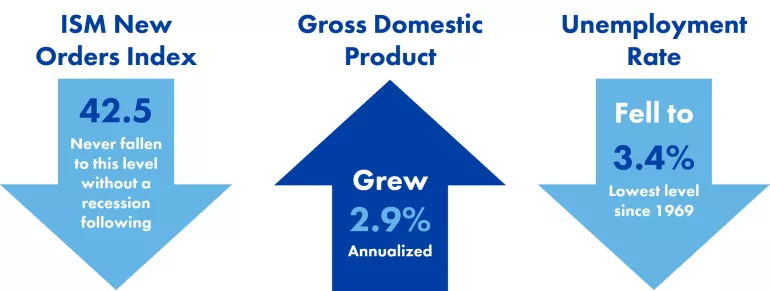February Economic Commentary: U.S. economy giving off mixed signals in early 2023

Chief Economist
Pohlad Companies
MINNEAPOLIS, MINNESOTA (February 8, 2023) - End of the year reports released in January showed an economy with little momentum going into the new year. A few of the early reports for January, however, suggest the economy is starting 2023 better than expected. The question is, how long will it last? The Fed’s efforts to slow down demand are bearing fruit. Most supply bottlenecks are easing as well, leading to a better balance between supply and demand that will enable inflationary pressures to continue to ease in 2023. Although inflation is slowing, the Fed is not convinced that price pressures are on a sustainable downward path and consequently has indicated that more rate increases are on the horizon.
Consumer Metrics
The December Consumer Price Index (CPI) showed year-over-year inflation at 6.5% and the year-over-year figure has now declined for six consecutive months after peaking at 9.1% in June. Additionally, on a month-to-month basis, the December reading declined for the first time since May 2020. The core CPI (excluding food and energy) eased on a year-over-year basis to 5.7%. The Producer Price Index (PPI), which provides an indication of pipeline pricing pressures, also fell in December by 0.5% – the sharpest monthly decline since April 2020. The disinflationary trend is likely to continue as the slowdown in shelter inflation will begin to register in early 2023. Nevertheless, despite the improving trend in inflation, the absolute numbers remain well above the Fed’s inflation target of 2.0%.

Retail sales fell 1.1% in December after declining 1.0% in November. Sales have declined three of the last four months and are now at the lowest level since May. Consumers are pushing back on higher prices forcing retailers to offer more discounts and promotions in order to clear inventories.
In addition to the contraction in retail sales, industrial production fell 0.8% in December following a downwardly revised decline in November of 0.6%. Housing starts were down 1.4% in December following a 1.8% decline in November. As stated earlier, the economy was clearly losing momentum heading into 2023.
Concern about the slowing economy was demonstrated in earnings reports from the big banks. The big six banks reported that $7.2 billion has been set aside for loan loss provisions – the most since Q2 2020.
Leading Economic Indicators, Manufacturing and Service
The Leading Economic Indicators (LEI) index has now declined for 10 consecutive months and is at the lowest level since February 2021. Year-over-year, LEI is -6.0% – a reading that historically has always foreshadowed an upcoming recession.
The January ISM manufacturing index declined to the lowest reading since May 2020. Of note, the new orders index fell to 42.5 from 45.1. The new orders index has never fallen to that level without a recession following. Output has weakened as a result of four consecutive months of shrinking orders. Additionally, the manufacturing survey indicated reductions in order backlogs, better supply-chain performance, lower prices, and better inventory levels.
The other ISM index, the ISM services index, however, has provided some indication that the year may be starting on a better footing. The service sector is much bigger than the manufacturing sector and thus warrants attention. The new orders index and the business activity index of the services ISM both recorded substantial gains indicating expansion. It is too early to say whether this will be sustained, but it is one of the few positives seen recently.
Gross Domestic Product
The initial report of Q4 2022 gross domestic product (GDP) showed that the U.S. economy slowed last quarter. Real GDP grew 2.9% annualized in Q4 2022, down from 3.2% the prior quarter. The 2.9% gain was primarily due to increased inventory building, a contraction in imports, and non-defense government spending. Importantly, final sales to private domestic purchasers only increased 0.2% for 2022 as a whole. Measured from Q4 2021 to Q4 2022, real GDP increased 1.0% compared with an increase of 5.7% from Q4 2020 to Q4 2021.
Employment
The headline number in the employment report for January was much stronger than expected, but details muddy the veracity of that strength. Non-farm payrolls increased by 517,000, and the unemployment rate fell to 3.4%, the lowest level since 1969. Much of the gain in payrolls, however, is due to seasonal factors and revisions to past data. Wage growth continued to slow, dropping to 4.4% year-over-year. That is higher than desired to bring inflation down to the Fed’s target of 2.0%, but it is moving in the right direction.
Fed Funds
Finally, the Fed raised the Fed Funds policy rate by 25 basis points to between 4.50% and 4.75% at their February 1 meeting. This was a smaller increase than the 50-basis point increase in December, but any hopes of an early end to their rate hiking were dashed by their statement that ongoing increases would still be required for them to meet their goal of price stability. Weakening demand is continuing to exert downward pressure on inflation, so their goal may be achieved sooner than expected. The Fed is moving closer to a pause in their policy tightening program, but how long rates remain elevated before rate cutting is initiated is still an open question. Fed actions hold the key to the path of the economy over the coming 12 to 24 months.
Insights
Research to help you make knowledgeable investment decisions